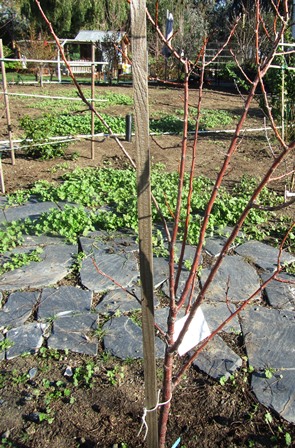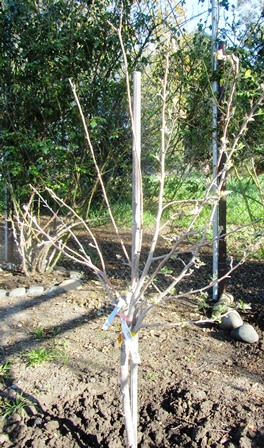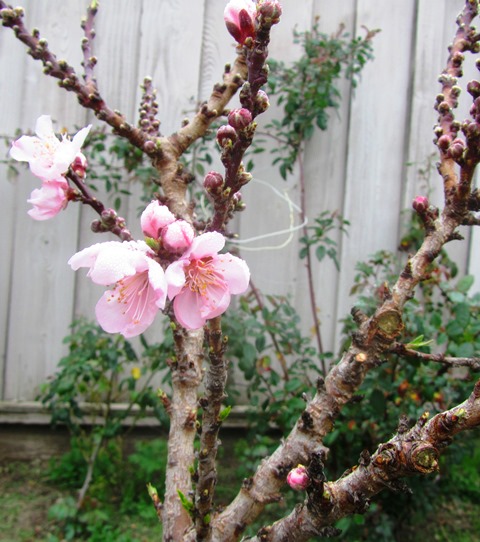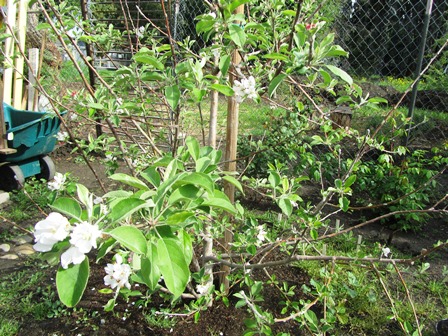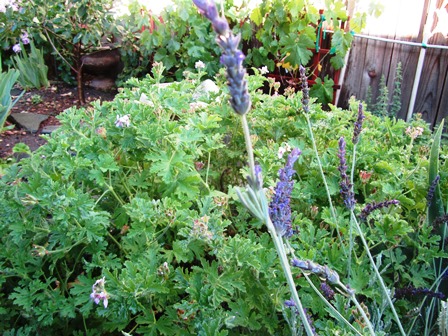Archive for February, 2015
What Could Be Easier than Growing Irises in Raised Beds?
When we first moved to the Bay Area from Miami, the heirs to the property behind ours gave us some bearded irises that had been planted in the 1950s by their parents. I recall the beauty of irises on my grandmother’s farm in Missouri. She called them flags.

For a lovely raised flower bed, plant other bloomers like cosmos, geraniums, pansies, nasturtiums, and marigolds with iris cultivars
Mostly colored in deep purples and blues, white, and pinkish-beige, the bearded irises have added an aesthetic appeal to our farmette that was mostly just a big field with a tiny house in the middle. We’ve planted them in the ground, along fences, and in raised boxes.
Easy to grow and maintain, the irises have become one of our favorite flowers. We’ve kept them going in our garden and they’ve rewarded us with many new rhizomes.
As we’ve continued to restore the farmette, we’ve built many four by six feet boxes for raised beds. The materials cost roughly $125 per box. We like them because we can easily control the soil (building it up with compost, manure, and other amendments), drainage, tilling, and weeds. Recently we decided to make irises the mainstay of a raised bed border.
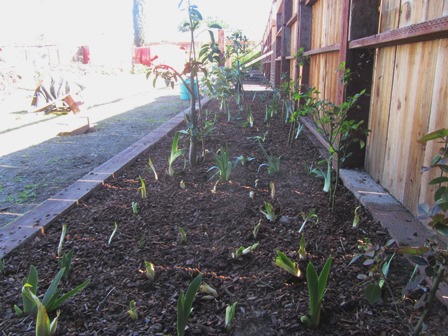
We’ve interplanted citrus and bearded irises in this raised bed spanning the length of the front fence
Over the weekend, we built a long raised bed that extends the entire length of the fencing on the southwestern side of our property. In it, we planted lots of citrus trees, climbing roses, and irises. If you are thinking of doing something comparable, have fun choosing from among the hundreds of cultivars of bearded and Siberian irises.
Plant them about three inches deep and a few inches apart in well drained, fertile soil. Irises need shade from the hottest sun and enjoy a deep drink of water, especially during blooming. I enjoy the ease of growing them in raised beds and love, love, love the magnificent color atop tall stalks when they bloom.
Early Bird Tips for Bare-root Fruit Trees
Gardeners understand that appearances can be deceiving. For example, during bare-root season (starting now in the Bay Area), twiggy fruit trees with no leaves are becoming plentiful offerings in local nurseries.
Bare-root trees are so-called because their roots are bare and packed in moist sawdust inside a burlap wrap. This makes it easy for the gardener to estimate the size of the planting hole (make the hole twice as deep and wide as the tree’s roots).
Plant two or three bare-root trees (select those that will pollinate each other for best results) in a single hole if space is a consideration. This is called high-density planting.
Consider a multi-grafted tree if you desire several types of fruit. Because the grafted trees use a basic tree and graft on scions of other varieties (often the same type of fruit such as apples), some branches will blossom and leaf out before others.
Another space saver in the garden is the espaliered tree. Choose a sunny place against a trellis, fence, or wall to train your tree, using wires for support. You will be directing its limbs to grow in a horizontal pattern.
All plants need water and food. During the winter, you may need very little water but in spring and summer check the soil often and when it’s dry down two inches, be sure and water your plant.
Fertilize your trees three times each year: after blossoming, after fruiting, and in the fall.
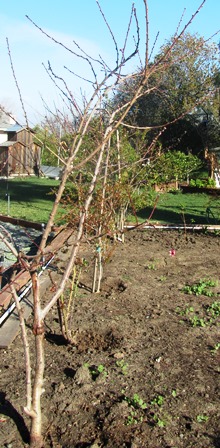
Planted in a row along a gravel path is a peach, a tea rose bush, an apricot, and a pomegranate tree
Prune your fruit trees in early winter, when the tree is dormant. With these early bird tips, your bare-root trees will get off to a great start.
Blooms over the Garden Gate
The nectarine trees are susceptible to Peach Leaf Curl and usually, I try to spray them three times before the next year’s blooms. Alas, this year, I didn’t complete the task before the tree broke bud.
Elsewhere, the almonds, apricots, and apples are blooming. So are some of the roses–Lady Banks, for example. Also, Fiesta and the beautiful Iceberg rose in the front of our house.
My neighbor’s two almond trees are covered in blooms of white blossoms. Last Friday, when I contacted a local beekeeper business, I was told they were closed to move their hives of bees out to pollinate the almond orchards. Farmers pay the beekeepers for “renting” those hives of industrious little bees for the job of pollinating their crops.
This is supposedly “bare root” season, but the warm weather coupled with the rain we had in December seems to have brought us an early spring. If you look over my garden gate, you will see signs of it everywhere.
Tis the time for Cool Season Planting
If you love the cool season plants like lettuce, spinach, kale, onions, leeks, sugar snap peas, and artichokes, Valentine’s Day weekend is the time to start planting cool season crops in the Bay Area and other warmer climates.
I put in onions throughout the cool season and am rewarded with burlap bags of red onions, yellow, white, and the walla walla variety for kitchen soups and other culinary creations during the first months of the year.
My husband is building more growing boxes (4 x 4 x 3) in which we shovel amended soil, some planting mix, bone meal, blood meal, compost, and chicken manure. The soil will grow almost anything.
This weekend, we’re moving a couple of citrus trees and three rose bushes. I’ll feed and water and watch for the new shoots to show within a week or two if the weather stays warm. So, you see, Valentine’s Day isn’t just for lovers but also people who love to garden.
Working the Beds after the Weekend Storm

A “Pineapple Express” rainstorm with gale-force winds blew out the power and made for slick roads as well as ponds in our clay soil
The weekend storm is still a vivid memory, what with the fence along one side of my property beaten down by high winds and pounding rain that also brought a power outage on Friday night.
But today with outside temperatures in the 70s Fahrenheit, I cleaned my strawberry beds. Somehow, mint had crept in and I don’t want mint with my berries although I like it served that way for dessert.
My neighbor’s relative, who’s visiting from Lebanon where they grow apples in his mountain village, share a suggestion for digging dried chicken manure around the bases of my trees. The high nitrogen will get them off to a great start and my trees have already broken bud (which is attracting the honeybees).
The wild bird population seems to have exploded and I see signs of nest building starting. The five suet cakes I hung in trees for the songbirds, blue jays, and woodpeckers last month are down to a fraction of their original size.
I extended the chicken run with poultry wire high enough to keep the my heritage girls from flying out. Now, they’ll have plenty of space on both sides of the chicken house to forage and out the beds I’m working.
Creating Functional Space in Our Small Farmhouse Kitchen
“There’s never enough storage space!” It’s become a lament I want to banish from my frequent utterances.

Our farmhouse kitchen counter and cabinets during early renovation. Carlos cut the sunburst pattern from blue-black granite
At roughly 1,000 square feet, our house isn’t terribly small by the 1970’s standard when the average American home was 1,400 square feet. And by the 195o’s standard of 983 square feet, my house is positively roomy. However, today, the average American house footprint stands at 2,598 square feet. That said, there is a tiny house movement on and that’s a good thing for the environment.
Having lived in larger houses, I can honestly say I love this smaller home. The costs for energy, upkeep, homeowner’s insurance, and property taxes are considerably less. The need for interior furnishings shrinks, too.
The downside is there is less space for storage. We have had to maximize our options. I keep bees and beekeeper supplies like honey jars and lids as well as my cases of jam jars and lids and the final, finished products have to be stored somewhere. And then there are my cookbooks (I’ve cut the collection from over a hundred to a quarter of that).
My designer/architect husband Carlos Carvajal came to my rescue by carving out some space for bookcase in the wall between the kitchen and the bar area.
He also took space from the kitchen to create a laundry area with washer and dryer and hid them behind bi-fold doors.
The bar area has a bank of lower cabinets that can hold glassware, appetizer dishes, and serving platters. He re-created a new cabinet unit from a bank of old upper kitchen cabinets, mounting them on the wall above the granite counter-top with an inset sink.
A narrow moveable butcher block cart on wheels with a couple of shelves could give me a little extra storage, if we could find one that would fit in the limited space near the oven.
I think we’ve maximized our storage options in the kitchen and created a highly functional space so maybe I can now abandon that lament.
Lavender Oil and Aloe Vera to Treat a Minor Burn
Lavender oil can reduce the pain of a minor burn and minimize inflammation. Since lavender oil is also an antiseptic, it serves to reduce the risk of a a secondary infection.
For a simple burn, run the afflicted area beneath cool water and then apply lavender oil. Next, cut a piece of aloe vera plant (if you have one growing in your kitchen or home), and apply the sap to the burn.
Perhaps you don’t own an aloe vera plant but have aloe vera cream. Cream or lotion of aloe vera without fixatives can also be applied to the burn. A dry bandage or Telfa pad to cover and possibly Tylenol or ibuprofen (for pain) is all that is required for a minor burn.
For a deeper burn or one acquired from contact with chemicals, electricity, or radiation, seek immediate medical attention.
How to Make Homemade Butter
A favorite memory of mine recalls my making butter with my grandmother in her farmhouse kitchen in Boone County, Missouri. All she needed was fresh cream and a jar with a lid.
My grandfather milked the cows and my grandmother would strain the liquid into galvanized cans. After the cream had risen to the top of the milk, she would skim off the cream into smaller cans, storing all of the cans in cool area at the back of the house until my grandfather could take the milk and cream to market. He always kept some back for Rosie’s homemade butter.
The buttermilk that was poured off the would then be chilled. It was his favorite drink after a long, hot day on the tractor working in the fields.
Rosie would hand me a glass jar with a screw top lid in which she’d poured a cup or two of cream and tell me to shake it. My energy and stamina would dictate how long the shaking would have to go on. She’d help. Eventually the butterfat solids and the butter milk would separate.
Rosie favored using a large glass jar with a metal lid that featured a beater and hand crank. Turning the crank beat the cream and amounted to less wear and tear on the arms. Either method worked by separating the liquid from the butterfat.
Today, beating heavy whipping cream (without additives) in a blender or mixer will accomplish the same result. The milk solids eventually become separated from the liquid, which can be poured off. The sweet creamy solid mass can then be salted and even colored if you wish, molded or shaped, chilled, and used. Also, you can leave out the yogurt and still make butter, but it won’t have that tangy flavor.
RECIPE: HOMEMADE CULTURED BUTTER
INGREDIENTS:
1 C heavy whipping cream (no additives)
1 Tablespoon natural, organic yogurt (no additives but with live cultures)
optional: 1/2 teaspoon fine sea salt
DIRECTIONS:
Pour the cream in a small to medium saucepan and warm over low heat to about 90 degrees Fahrenheit.
Stir in yogurt and remove from heat.
Cover and let rest for 24 hours on the kitchen counter to allow the mixture to thicken.
After the cream has thickened, chill in the refrigerator.
Pour chilled mixture into a blender jar or electric mixer bowl.
Beat on a low speed to reduce splatter.
Add salt, if desired.
Beat the liquid and solids separate into massive chunks.
Wrap the butter into a cheesecloth and squeeze over a large bowl to drain out the rest of the liquid. (The buttermilk makes a refreshing drink or can be used to make biscuits).
Mold by pressing the he butter into a plastic mold or an old-fashioned butter molding box. Alternatively, you can shape the butter into small balls using a melon ball scoop.
Hint: To make a flavored butter, add fresh wash, dried, and chopped herbs such as basil and garlic; or cranberries and orange zest. Or, add to the butter apricots or figs (peeled and chopped).
 Facebook
Facebook Goodreads
Goodreads LinkedIn
LinkedIn Meera Lester
Meera Lester Twitter
Twitter








